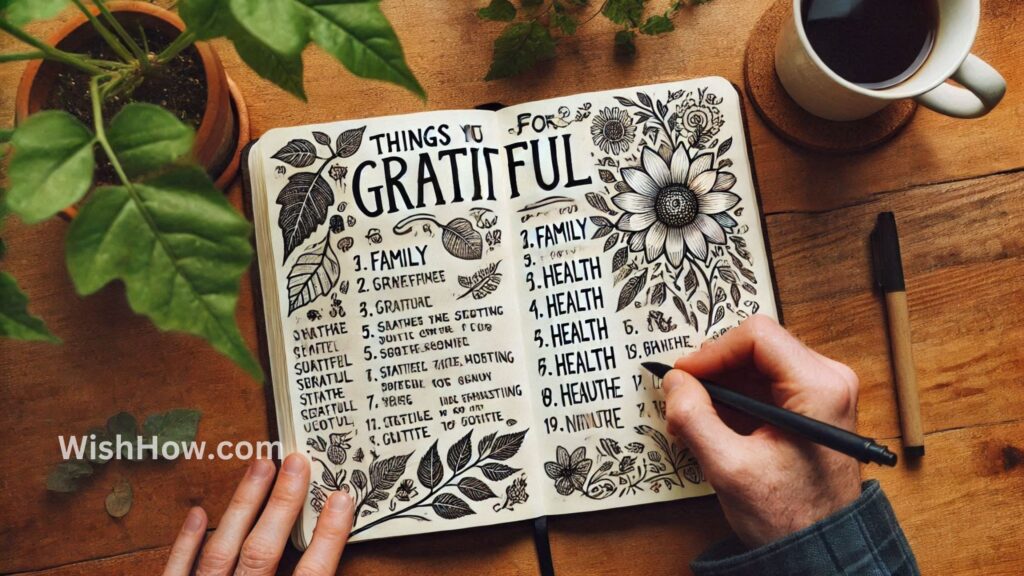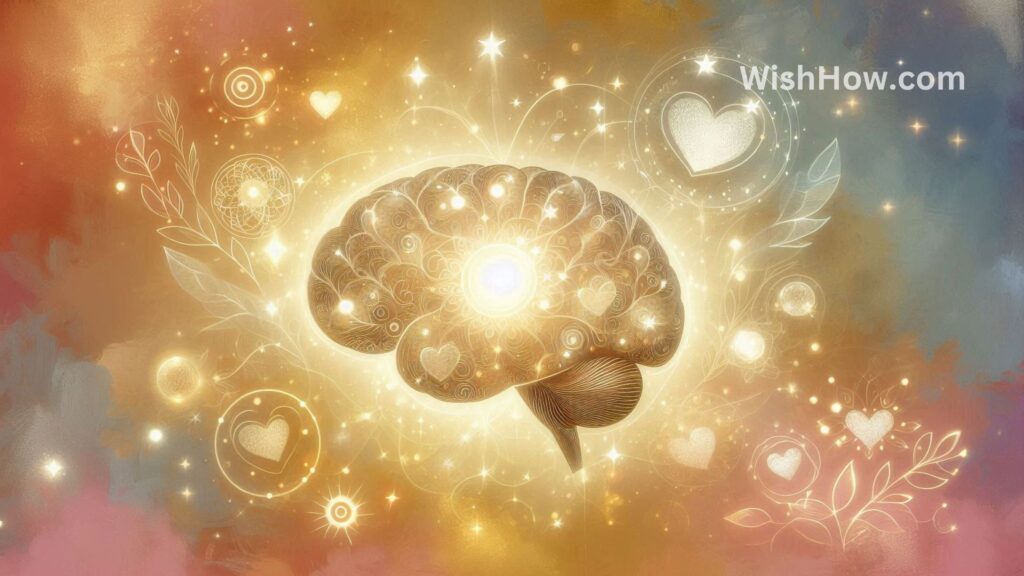Practicing gratitude can really change your life. It’s amazing how it can improve your mental health and strengthen your relationships. When you live with gratitude, you start noticing the small wins in your day—like the bus arriving right on time, someone holding the door for you, or waking up to sunlight streaming through your window. These little moments add up and create a sense of happiness that helps you see the good more easily over time.
Building a habit of gratitude isn’t hard; it just takes practice. The more you focus on what you’re thankful for, the more you’ll find things to appreciate!
Start by paying attention. Think about the times you say “thank you.” Is it just a quick, automatic response? Are you rushing through it or feeling distracted? Take a moment to check in with yourself—how are you feeling when you say it?
Now, try this: pick one moment each day to slow down. When you feel the urge to say “thanks,” pause for a second. Think about why you’re grateful—not just for the gesture, but for the kindness behind it. Then, say thank you with intention.
How Do I Practice Gratitude?
Robert Emmons, a psychology professor and expert on gratitude at the University of California, Davis, breaks gratitude down into two simple parts:

- Recognizing the good things we’ve received.
- Appreciating the people who bring goodness into our lives.
Most of us know it’s important to say thank you to the people who help us or to take a moment to silently appreciate the good things in our lives. But did you know that gratitude comes with a ton of benefits? Research shows it can boost your immune system, help you sleep better, make you feel more optimistic, and bring more joy into your life. Gratitude can also make you more helpful and generous while reducing feelings of loneliness and isolation.
Want to enjoy some of these amazing benefits? Start your own gratitude practice today!
Practicing Daily Gratitude
As Jon Kabat-Zinn wisely said, “The little things? The little moments? They aren’t little.” Simple acts like saying thank you or holding the door for someone can completely brighten your day.
Gratitude is one of the most powerful tools for rewiring your brain to feel more joy and less stress. Here are 10 easy ways to practice gratitude and make it a part of your daily life:

- Keep a Gratitude Journal
Take a few minutes each day to jot down the things you’re thankful for—whether it’s a kind gesture, something you love about yourself, or a special moment with someone you care about. Over time, these reminders of gratitude can weave positivity into your life. - Remember the Hard Times
Thinking back on tough moments can help you appreciate how far you’ve come. That contrast makes the good times feel even sweeter and gives you more reasons to be grateful. - Ask Yourself Three Questions
Reflect on your relationships by asking:- “What have I received from this person?”
- “What have I given to them?”
- “What difficulties have I caused?”
These questions can deepen your appreciation for the people in your life.
- Share Your Gratitude
Expressing thanks can strengthen your connections with others. The next time someone does something kind for you, take a moment to let them know how much you appreciate it. - Appreciate Your Senses
Your ability to touch, see, hear, smell, and taste is a daily miracle. When you focus on these gifts, you’ll feel more connected to the beauty of being alive. - Use Visual Reminders
Forgetfulness is one of the biggest obstacles to gratitude. Surround yourself with reminders—photos, quotes, or even sticky notes—to prompt grateful thoughts throughout the day. - Make a Gratitude Vow
Write a simple promise, like “I will count my blessings every day,” and post it where you’ll see it often. Studies show that making a commitment like this increases the chances of following through. - Watch Your Words
Grateful people use words like “gift,” “blessing,” “fortunate,” and “abundance.” Instead of focusing on what you lack, notice the good things others bring into your life. - Practice Grateful Actions
Smile, say thank you, or write a gratitude letter. These small actions create positive feelings and reinforce the habit of gratitude. - Get Creative
Look for new ways to feel and show gratitude. Maybe it’s starting a gratitude jar, taking photos of things you’re thankful for, or creating a gratitude playlist.
Wherever You Go, There You Are: Mindfulness Meditation in Everyday Life
$12.79 (as of April 28, 2025 21:51 GMT -07:00 - More info)How do you practice gratitude? Feel free to share your favorite ideas and inspire others!
Try This 5-Minute Gratitude Meditation

Savor the Little Things
When gratitude feels out of reach, try this simple exercise: slow down and tune into your senses. You don’t need a big reason to feel thankful—sometimes it’s just the joy of a warm cup of coffee or a good book. By noticing the little things, you can start to appreciate the everyday beauty around you.
Start with Your Breath
Take a deep breath and let it anchor you in the present moment. Our minds tend to race with busyness, so let this moment be a pause. Relax your shoulders, feel your breath, and shift your focus to gratitude.
Notice What You See
Look around and pick one thing you’re grateful for. Maybe it’s a color, a shadow, or even the movement of leaves in the wind. Whatever it is, remind yourself that this moment is unique—it will never be exactly like this again.
Appreciate a Scent
Now, shift your attention to your sense of smell. What scents are around you? Maybe it’s the comforting aroma of coffee, a favorite candle, or even the freshness of the air. Let yourself enjoy it and feel grateful for the way it uplifts or intrigues you.
Tune Into Sounds
Next, listen closely. What do you hear? Perhaps it’s music that lifts your spirits, the laughter of children, or even the steady beat of your own heart. Take a moment to appreciate the richness of sound and how it connects you to the world.
Feel the Power of Touch
Now, focus on touch. If someone is nearby, give or receive a hug and savor the comfort of human connection. If you have a pet, take a moment to cuddle them. Even the texture of a soft blanket or a favorite sweater can spark gratitude.
Look Around You
Take in the objects around you. Notice the effort and care that went into creating them. From their design to their packaging, countless people contributed to making your life a little easier. Feel grateful for their work and creativity.
Carry Gratitude Forward
As you finish, let this sense of thankfulness stay with you. Try a small challenge today: say thank you to everyone who helps you, even if it’s their job. Gratitude not only opens your heart but also makes life feel richer.
End with Thanks
Thank you for taking the time to explore this gratitude practice. I’m grateful for your effort, your presence, and your energy. Remember, life is precious, and so are you. Have a beautiful, gratitude-filled day!
Daily Gratitude Journaling

The Power of Journaling
Journaling, whether in a diary, notebook, or just scribbling notes on random pieces of paper, has a rich history and remains popular today. Anaïs Nin, a famous 20th-century writer, believed that writing helps us “taste life twice”—once in the moment and again when we reflect on it later. She was onto something! Writing has a unique way of shifting our awareness, and journaling can be an easy and powerful way to experience that shift.
As a hobby, journaling is affordable, portable, and a great way to improve our awareness. It helps us make sense of our thoughts, feelings, and experiences, turning our unfolding story into something clearer. It’s a chance to slow down, breathe, and be honest about what we’re feeling and thinking—something often called expressive writing, especially in therapy. And journaling isn’t just about words. You can also create visual journals, filled with sketches, doodles, or any form of art that speaks to you. The best part? No need to worry about perfect grammar or getting likes on social media. Journaling is for you, and you alone.
How to Get Started
There’s no wrong way to keep a gratitude journal, but here are some tips to help you get started:
- Write down up to five things you’re grateful for. The key is to make it physical—don’t just think about it, write it down. These things can be small, like “The delicious sandwich I had for lunch,” or big, like “My sister had a healthy baby boy.” The goal is to remember something good and feel the positive emotions that come with it.
9 Tips for Gratitude Writing
As you write, keep these nine tips in mind:
- Be specific. The more specific you are, the more powerful your gratitude will be. Instead of writing, “I’m grateful for my co-workers,” try something like, “I’m grateful that my co-workers brought me soup when I was sick on Tuesday.”
- Go for depth, not a list. It’s better to dive into one meaningful thing than to write a long list. Focus on the details that make you feel truly grateful.
- Get personal. Gratitude for people tends to have a bigger impact than for things. Think about the people who’ve made a difference in your life.
- Try subtraction, not just addition. Imagine your life without certain people or things. What have you avoided or escaped? Recognizing the negatives you didn’t face can help you appreciate the positives more.
- See good things as gifts. Treating the good things in your life as gifts helps you avoid taking them for granted. Savor them like a present you’re truly thankful for.
- Savor surprises. When something unexpected happens, take time to appreciate it. Surprises often bring a deeper sense of gratitude.
- Change it up if you repeat. It’s fine to write about the same people or things, but focus on a different aspect of them each time.
- Write regularly. Whether you journal every other day or once a week, pick a time and stick with it.
- Don’t overdo it. Research shows that journaling 1-3 times a week is more effective than writing daily. This helps keep you from becoming numb to the good things around you.
Journaling can help you stay mindful, reflect on what matters, and find gratitude in both the big and small moments.
Gratitude and the Brain

Breaking the Habit of Negative Thinking and Self-Talk
$12.85 (as of April 28, 2025 21:51 GMT -07:00 - More info)4 Ways to Train Your Brain to Practice More Gratitude
- Take time to notice what’s around you
Mindfulness helps you stay present and aware of the moment. If you’re already a grateful person, you’re probably more in tune with the gestures of others. The more you pay attention, the more likely you’ll notice all the good around you that can spark feelings of gratitude, which leads to more satisfaction and happiness. Being aware of simple things like the beauty of nature, someone’s kindness, or the chance to have a job, helps us appreciate life more. For example, being mindful of someone helping you in the kitchen or noticing the color of the sky can bring out gratitude just by observing those little things.
- Practice gratitude for the little things
We often remember to be grateful for big events like graduating or getting married, but it’s also important to be thankful for the small things we experience every day. For instance, simply being grateful for a meal is a powerful way to practice gratitude. Think about how the food in front of you fills your hunger and delights your taste buds. This can turn every meal into a moment of gratitude! Another simple thing to be grateful for is a good night’s sleep. By focusing on these little moments of comfort, we can bring more peace and satisfaction into our lives.
- Share your gratitude with loved ones
We all sometimes take our loved ones for granted. The next time you notice something kind they’ve done, why not show your gratitude with a simple “thank you” or a hug? It’s important to appreciate those around us and not let their kindness go unnoticed. By showing gratitude, we strengthen our relationships and make those bonds even more meaningful.
- Spread gratitude on social media
While social media can sometimes feel negative, using it to share moments of gratitude can help create a more positive online environment. You could share a happy memory, a lesson you learned from a book, or a photo of a place you’re thankful for. By spreading good vibes in our own unique way, we can help inspire others to appreciate the good things in their lives too. Let’s all do our part in making the digital world a little brighter!
Training our brains to practice gratitude is possible when we stay mindful of ourselves, each other, and our surroundings. Let’s keep expanding our circle of appreciation. Feel free to share your own ideas for staying grateful!
3 Ways Gratitude Benefits Our Brains
- It helps relieve stress and pain
Gratitude activates parts of the brain that are linked to social connection and pleasure. These areas are also connected to the brain’s emotional regulation centers, which control things like heart rate and stress levels. When we feel grateful, it helps reduce stress, which in turn can ease pain. By recognizing the help we receive from others, we relax our bodies and experience the calming effects of gratitude.
- It can improve our health over time
Gratitude is tied to the brain’s “mu opioid” networks, which are activated when we experience close connection or relief from pain. This connection may have evolved from the need to groom each other to prevent parasites. In other words, since gratitude relies on brain networks related to social bonding and stress relief, it could explain why practicing gratitude benefits our health over time.
- It can help those with depression
Even more promising, a study by researcher Prathik Kini and colleagues at Indiana University showed that practicing gratitude can actually change the brain function of people with depression. They found evidence that gratitude can trigger structural changes in the brain, particularly in areas linked to emotional regulation. This supports the idea that gratitude can help rewire the brain and improve mental health.
Also Read: How do I Shift from Negative Thinking to Gratitude?
The Science of Gratitude
Gratitude is a way to embrace everything that makes our lives what they are. It’s not just about feeling happy when things are going well; it’s about opening our hearts to see the goodness around us, no matter what’s happening. By practicing gratitude, we start to notice all the good things we’re receiving every day.

Over the past two decades, research in social science has shown that gratitude benefits nearly every aspect of our lives. It plays a big role in improving our well-being and even our physical health. The Greater Good Science Center at UC Berkeley, a leader in studying social and emotional health, calls gratitude the “social glue” that helps build strong, lasting relationships.
Robert Emmons, a psychology professor at UC Davis and an expert on gratitude, explains that gratitude has two parts. First, it’s recognizing the good things around us—things we often take for granted. Second, it’s understanding that these good things come from others or something greater than ourselves. Gratitude reminds us that we wouldn’t be where we are without help from others.
A Brain Built on Gratitude
Gratitude isn’t just a passing feeling. Studies show that practicing gratitude—whether through writing gratitude letters or keeping a gratitude journal—can improve mental health and well-being. These practices also help us feel more satisfied with life and even boost self-esteem.
The Science: Feel Happier
In one study, nearly 300 adults seeking counseling wrote a gratitude letter each week for three weeks. Those who practiced gratitude reported better mental health three months later compared to those who didn’t. Another study, known as “Three Good Things,” had participants write down three positive things that happened each day and the reasons behind them. Even six months later, people who practiced this felt happier and less depressed.
How It Works: Strengthening Positive Recall
Why does practicing gratitude make us feel better? Studies show that people tend to focus more on their struggles than their blessings. By shifting our focus to the good things, we can boost our happiness and optimism. Nancy Davis Kho, author of The Thank-You Project, explains that practicing gratitude helps us see the good things even in tough times. She suggests writing thank-you letters to people who inspire us or whose work brings us joy.
Why Practice: Build Resilience
Gratitude isn’t just about feeling happy—it can make us more resilient when life gets tough. In The Gratitude Project, Robert Emmons writes that gratitude doesn’t just reduce negative feelings; it magnifies positive emotions, helping us bounce back from challenges.
Nourish a Grateful Body
Gratitude can benefit our health in surprising ways. Grateful people tend to experience fewer common health problems like headaches, digestive issues, and sleep problems. Research shows that gratitude can even help us feel better physically. In one study, college students who wrote about things they were grateful for once a week for 10 weeks reported fewer health complaints than those who didn’t practice gratitude.
How It Works: Calm the Nervous System
Gratitude may also help calm the body. When we feel grateful, it can lower blood pressure and improve heart health. One study of heart-failure patients found that those who practiced gratitude had better heart-rate variability, which is a sign of good heart health. It’s the body’s way of relaxing and restoring energy.
Why Practice: Make Healthier Choices
Interestingly, gratitude can also encourage healthier choices. Research shows that grateful people tend to make better decisions when it comes to nutrition and exercise. In one study, high school students who practiced gratitude chose healthier foods and showed better eating habits than those who didn’t.
Thankful for Those We Love
Gratitude also strengthens our relationships. Psychologist Sara Algoe’s “find-remind-bind” theory suggests that gratitude helps us form new relationships (find), appreciate existing ones (remind), and motivate us to keep them strong (bind). Studies show that expressing gratitude can make us feel more connected and more likely to invest in relationships.
The Science: Stronger Connections
Gratitude helps us build better social connections, which are key to our well-being. People who practice gratitude often feel motivated to improve themselves, making them more likely to strengthen their relationships. One study found that after writing gratitude letters, students felt more connected to others and wanted to invest in those relationships.
How It Works: Better Communication
Gratitude also helps improve communication in romantic relationships. A thoughtful gesture from a partner can trigger a cycle of kindness, where both partners feel more connected and satisfied. Studies show that expressing gratitude makes it easier to talk through disagreements and strengthens trust.
Why Practice: It’s Better Together
“Gratitude has made our family closer,” says Randi Joy, who practices gratitude with her family. Whether it’s sharing what they’re grateful for during a walk or at dinner, Randi’s family has built a deeper connection through gratitude.
Whether you’re looking to improve your mental health, protect your physical health, or strengthen your relationships, research shows that gratitude offers major benefits. The key takeaway: practicing gratitude can change your perspective and help you handle life’s challenges with more resilience.






